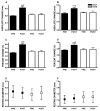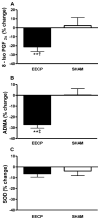Enhanced external counterpulsation improves peripheral artery flow-mediated dilation in patients with chronic angina: a randomized sham-controlled study
- PMID: 20921442
- PMCID: PMC2963100
- DOI: 10.1161/CIRCULATIONAHA.109.923482
Enhanced external counterpulsation improves peripheral artery flow-mediated dilation in patients with chronic angina: a randomized sham-controlled study
Abstract
Background: Mechanisms responsible for anti-ischemic benefits of enhanced external counterpulsation (EECP) remain unknown. This was the first randomized sham-controlled study to investigate the extracardiac effects of EECP on peripheral artery flow-mediated dilation.
Methods and results: Forty-two symptomatic patients with coronary artery disease were randomized (2:1 ratio) to thirty-five 1-hour sessions of either EECP (n=28) or sham EECP (n=14). Flow-mediated dilation of the brachial and femoral arteries was performed with the use of ultrasound. Plasma levels of nitrate and nitrite, 6-keto-prostaglandin F(1α), endothelin-1, asymmetrical dimethylarginine, tumor necrosis factor-α, monocyte chemoattractant protein-1, soluble vascular cell adhesion molecule, high-sensitivity C-reactive protein, and 8-isoprostane were measured. EECP increased brachial (+51% versus +2%) and femoral (+30% versus +3%) artery flow-mediated dilation, the nitric oxide turnover/production markers nitrate and nitrite (+36% versus +2%), and 6-keto-prostaglandin F(1α) (+71% versus +1%), whereas it decreased endothelin-1 (-25% versus +5%) and the nitric oxide synthase inhibitor asymmetrical dimethylarginine (-28% versus +0.2%) in treatment versus sham groups, respectively (all P<0.05). EECP decreased the proinflammatory cytokines tumor necrosis factor-α (-16% versus +12%), monocyte chemoattractant protein-1 (-13% versus +0.2%), soluble vascular cell adhesion molecule-1 (-6% versus +1%), high-sensitivity C-reactive protein (-32% versus +5%), and the lipid peroxidation marker 8-isoprostane (-21% versus +1.3%) in treatment versus sham groups, respectively (all P<0.05). EECP reduced angina classification (-62% versus 0%; P<0.001) in treatment versus sham groups, respectively.
Conclusions: Our findings provide novel mechanistic evidence that EECP has a beneficial effect on peripheral artery flow-mediated dilation and endothelial-derived vasoactive agents in patients with symptomatic coronary artery disease.
Conflict of interest statement
Figures




Comment in
-
Letter by Gloekler et al regarding article, "Enhanced external counterpulsation improves peripheral artery flow-mediated dilation in patients with chronic angina: a randomized sham-controlled study".Circulation. 2011 Jun 14;123(23):e631. doi: 10.1161/CIRCULATIONAHA.110.005942. Circulation. 2011. PMID: 21670237 No abstract available.
Similar articles
-
Enhanced external counterpulsation improves peripheral artery function and glucose tolerance in subjects with abnormal glucose tolerance.J Appl Physiol (1985). 2012 Mar;112(5):868-76. doi: 10.1152/japplphysiol.01336.2011. Epub 2011 Dec 22. J Appl Physiol (1985). 2012. PMID: 22194326 Clinical Trial.
-
Enhanced external counterpulsation creates acute blood flow patterns responsible for improved flow-mediated dilation in humans.Hypertens Res. 2013 Apr;36(4):297-305. doi: 10.1038/hr.2012.169. Epub 2012 Oct 18. Hypertens Res. 2013. PMID: 23076403 Clinical Trial.
-
Enhanced external counterpulsation improves endothelial function and exercise capacity in patients with ischaemic left ventricular dysfunction.Clin Exp Pharmacol Physiol. 2014 Sep;41(9):628-36. doi: 10.1111/1440-1681.12263. Clin Exp Pharmacol Physiol. 2014. PMID: 24862172 Free PMC article. Clinical Trial.
-
Influence of enhanced external counterpulsation on endothelial function: a meta-analysis of randomized controlled trials.Scand Cardiovasc J. 2023 Dec;57(1):2273223. doi: 10.1080/14017431.2023.2273223. Epub 2023 Oct 24. Scand Cardiovasc J. 2023. PMID: 37876280
-
Enhanced external counterpulsation: A unique treatment for the "No-Option" refractory angina patient.J Clin Pharm Ther. 2021 Apr;46(2):295-303. doi: 10.1111/jcpt.13330. Epub 2021 Jan 7. J Clin Pharm Ther. 2021. PMID: 33410549 Free PMC article. Review.
Cited by
-
Effect of Enhanced External Counterpulsation and Cardiac Rehabilitation on Quality of Life, Plasma Nitric Oxide, Endothelin 1 and High Sensitive CRP in Patients With Coronary Artery Disease: A Pilot Study.Ann Rehabil Med. 2015 Apr;39(2):191-8. doi: 10.5535/arm.2015.39.2.191. Epub 2015 Apr 24. Ann Rehabil Med. 2015. PMID: 25932415 Free PMC article.
-
Enhanced external counterpulsation reduces indices of central blood pressure and myocardial oxygen demand in patients with left ventricular dysfunction.Clin Exp Pharmacol Physiol. 2015 Apr;42(4):315-20. doi: 10.1111/1440-1681.12367. Clin Exp Pharmacol Physiol. 2015. PMID: 25676084 Free PMC article. Clinical Trial.
-
Cause or effect of arteriogenesis: compositional alterations of microparticles from CAD patients undergoing external counterpulsation therapy.PLoS One. 2012;7(10):e46822. doi: 10.1371/journal.pone.0046822. Epub 2012 Oct 8. PLoS One. 2012. PMID: 23056467 Free PMC article. Clinical Trial.
-
A Defined, Plant-Based Diet and Other Integrative Therapies Improve Functional Status and Ejection Fraction while Reducing Medications in Patients With Heart Failure: A Case Series.Am J Lifestyle Med. 2024 Sep 6:15598276241281475. doi: 10.1177/15598276241281475. Online ahead of print. Am J Lifestyle Med. 2024. PMID: 39554929 Free PMC article.
-
Effect of enhanced external counterpulsation on coronary microcirculation dysfunction (CMD) in patients with coronary artery disease (EECP-CMD II): study protocol of a single-centre, open-label, parallel group, randomised controlled trial.BMJ Open. 2024 Aug 25;14(8):e086901. doi: 10.1136/bmjopen-2024-086901. BMJ Open. 2024. PMID: 39182936 Free PMC article.
References
-
- Arora RR, Chou TM, Jain D, Fleishman B, Crawford L, McKiernan T, Nesto RW. The multicenter study of enhanced external counterpulsation (MUST-EECP): effect of EECP on exercise-induced myocardial ischemia and anginal episodes. Journal of the American College of Cardiology. 1999;33:1833–1840. - PubMed
-
- Lawson WE, Hui JC, Zheng ZS, Burgen L, Jiang L, Lillis O, Oster Z, Soroff H, Cohn P. Improved exercise tolerance following enhanced external counterpulsation: cardiac or peripheral effect? Cardiology. 1996;87:271–275. - PubMed
-
- Urano H, Ikeda H, Ueno T, Matsumoto T, Murohara T, Imaizumi T. Enhanced external counterpulsation improves exercise tolerance, reduces exercise-induced myocardial ischemia and improves left ventricular diastolic filling in patients with coronary artery disease. Journal of the American College of Cardiology. 2001;37:93–99. - PubMed
-
- Masuda D, Nohara R, Hirai T, Kataoka K, Chen LG, Hosokawa R, Inubushi M, Tadamura E, Fujita M, Sasayama S. Enhanced external counterpulsation improved myocardial perfusion and coronary flow reserve in patients with chronic stable angina; evaluation by(13)N-ammonia positron emission tomography. Eur Heart J. 2001;22:1451–1458. - PubMed
-
- Stys TP, Lawson WE, Hui JC, Fleishman B, Manzo K, Strobeck JE, Tartaglia J, Ramasamy S, Suwita R, Zheng ZS, Liang H, Werner D. Effects of enhanced external counterpulsation on stress radionuclide coronary perfusion and exercise capacity in chronic stable angina pectoris. Am J Cardiol. 2002;89:822–824. - PubMed
Publication types
MeSH terms
Substances
Grants and funding
LinkOut - more resources
Full Text Sources
Medical
Research Materials

